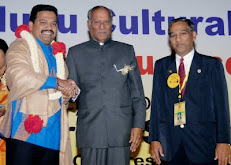
Baahubali: Why India's priciest film has done well at box office
- 13 July 2015
- India
India's battle epic Baahubali (Strong Man), billed as its most expensive film to date, was released in cinemas on Friday. Sudha G Tilak explains why the film has caught movie-mad India's imagination.
With its song-and-dance idiom, Bollywood has long been the symbol of popular Indian cinema, both at home and abroad.
But a little known fact is that south India's Hyderabad-based Telugu film industry is much more prolific than Bollywood. It also routinely churns out more expensive films than its Mumbai counterpart.
A good case in point is Baahubali, a $39m (£25m) Telugu-language film, which has made headlines for being India's most expensive film.
Directed by SS Rajamouli, the film, originally shot in the south Indian language Telugu, and dubbed in a number of other languages, set the box office on fire when it opened on Friday.
So why has the film worked? One reason could be hype and scale.
In the run-up to its release, the film's producers set the tone for the epic scale of the movie with the release of a 51,000 sq ft (4,738 sq m ) promotional poster, which it touted as the "world's largest poster".
The massively publicised budget didn't hurt either.
But Baahubali has also successfully married the traditional Indian film template with state-of-the-art special effects.
Saga of Revenge
For one, Baahubali is lavish and spectacular with breathtaking locales and special effects. And secondly, the story strikes a chord with a traditional Indian movie-going audience.
The plot revolves around an Indian epic of warring princes, scheming aristocrats, loyal generals, valiant queens and lion-hearted kings. It is a cocktail of Indian mythological and familiar fairytale plotlines of revenge and good triumphing over evil, ticking all the boxes that are familiar tropes in Telugu mythology.
There is the lost prince Baahubali - thus named because of his powerful arms - and who grows up in obscurity in a tribal hamlet, completely ignorant of that fact that he is heir to the throne of a powerful kingdom across the mountains.
There is the powerful figure of the Indian mother whose impassioned love for her son forms the core of the hero's vendetta to avenge her humiliation.
There are angelic damsels whose marksmanship and serious sword skills are no match for the hero's charms in the romance department.
The acting is marked by glowering and comic book action with lengthy hyperboles that Telugu films are famous for.
Hollywood-style effects
The film's dazzling special effects have also drawn audiences to theatres, and are inviting comparisons to Hollywood's best.
The film has convincingly recreated magical kingdoms, thrilling bull fights, breathtaking flights across mountain peaks and gripping chases down icy slopes. A spectacular 40-minute war sequence comes as a fitting grand finale.
And this is not the first time Mr Rajamouli has successfully translated mythology on to the big screen.
His 2010 film Maghadheera (The Mighty Valiant Hero), based on historical fiction, was also a big success.
The film is made in two parts and the second part of Baahubali is set for release next year.
Clearly, its successful formula of fusing mythology with special effects could become the next big thing in Indian cinema.
Sudha G Tilak is an independent journalist and writer based in Delhi



.jpg)
.jpg)
.jpg)
.jpg)
.jpg)

